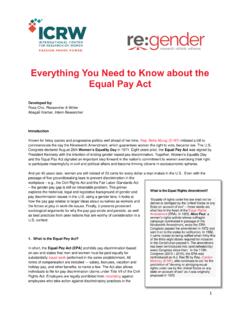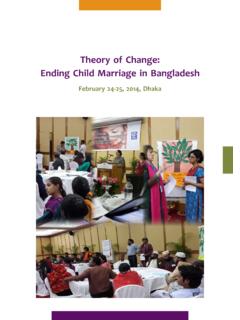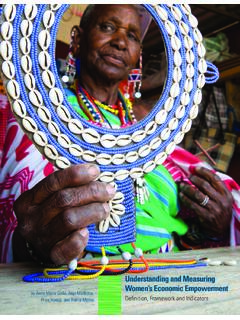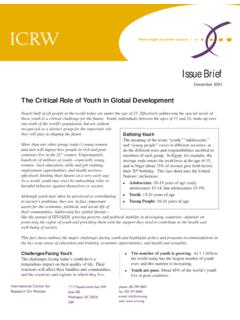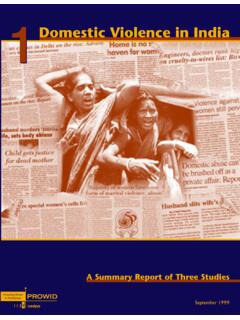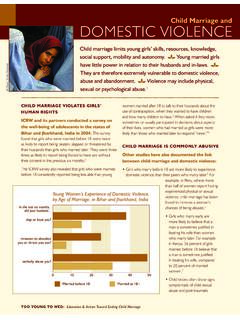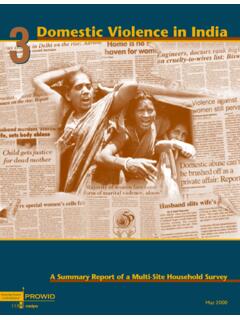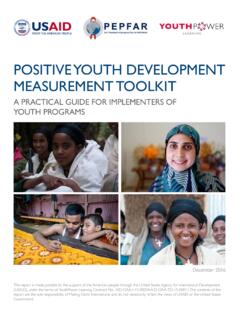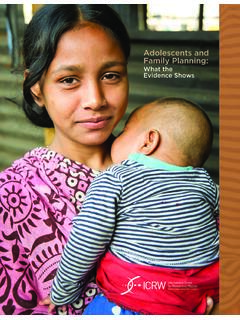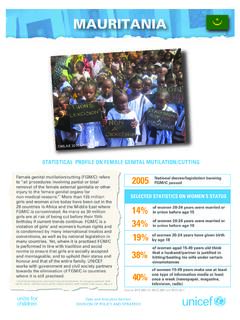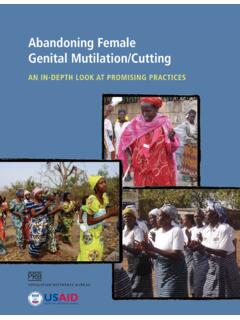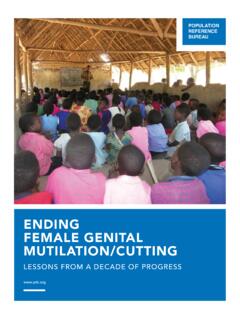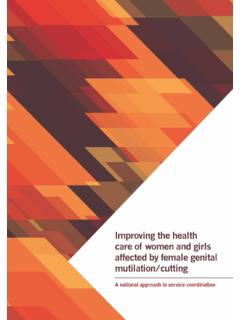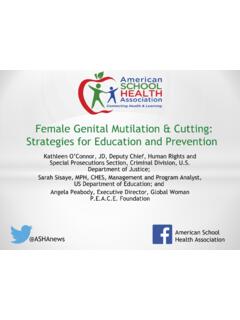Transcription of LEVERAGING EDUCATION TO END FEMALE GENITAL …
1 1 LEVERAGING EDUCATION to End FEMALE GENITAL mutilation / cutting WorldwideInternational Center for Research on WomenLEVERAGING EDUCATION TO END FEMALE GENITAL mutilation / cutting WORLDWIDEP repared by the International Center for Research on Women (ICRW)This paper was prepared under a grant funded by the Wallace Global Fund. It synthesizes the evidence linking FEMALE GENITAL mutilation / cutting and EDUCATION , highlighting promising approaches to address both issues. This paper also provides actionable guidance to programmers, policymakers and funders to move these issues EDUCATION to End FEMALE GENITAL mutilation / cutting Worldwide 2 International Center for Research on WomenOVERVIEW OF FEMALE GENITAL mutilation / cutting (FGM/C) FEMALE GENITAL mutilation / cutting (FGM/C)1 is a practice that involves the complete or partial removal of the FEMALE genitalia for non-medical reasons (WHO, 2008).
2 Worldwide, estimates indicate that more than 200 million girls and women have undergone FGM/C and more than three million girls and women are currently at risk of FGM/C. With the global population expected to rise in countries where FGM/C is concentrated, the number of women and girls at risk of FGM/C annually is expected to increase to about four million by 2050 (Shell-Duncan et al., 2016; UNICEF, 2016). FGM/C occurs worldwide, with evidence of its practice highly concentrated in 27 countries in sub-Saharan Africa. Other countries for which nationally representative data exist include Iraq, Yemen and Indonesia. Figures on FGM/C prevalence should be regarded with caution as many data gaps remain,for example, in countries where the practice reportedly occurs but where no data exist at all.
3 Anecdotal reports, pilot studies and small scale studies seem to indicate this hidden practice also occurs in Colombia, India, Iran, Malaysia, Oman, Saudi Arabia and the United Arab Emirates, but our understanding is limited given that no nationally representative data exist (UNICEF, 2016; Shell-Duncan et al., 2016). Two-thirds of all women who have experienced FGM/C reside in just four countries: Egypt, Ethiopia, Nigeria and Sudan (Shell-Duncan et al., 2016) and one in every five women who has experienced FGM/C is from Egypt (UNICEF, 2013). While FGM/C is primarily performed on children and adolescents, age at cutting varies widely, with some girls undergoing FGM/C during infancy, while other girls and women undergo FGM/C later in life, often in preparation for marriage.
4 In the 22 countries for which nationally representative data on age at cutting are available, the majority of girls in 12 countries were cut before the age of five. But notable exceptions such as Egypt, Kenya and the Central African Republic exist, where cutting continues well into the teen years (Shell-Duncan et al., 2016). In developed countries, FGM/C occurs predominantly among diaspora communities representing countries where FGM/C is prevalent. FGM/C has also been reported in Western Europe, the United States, Australia, New Zealand and Canada, although data on the practice in these diaspora communities have been difficult to obtain (Shell-Duncan et al., 2016). Approximately 513,000 women and girls in the United States have undergone or were at risk for FGM/C in 2012, which is more than three times higher than 1990 data (Goldberg et al, 2016).
5 In 2011, there were at least 103,000 immigrant women and girls in the United Kingdom who had experienced FGM/C (Macfarlane & Dorkenoo, 2015). 1 As of February 2016, WHO began referring to this practice exclusively as FEMALE GENITAL mutilation . Past definitions of this practice included FEMALE GENITAL mutilation / cutting . The term cutting was incorporated into terminology referring to this practice in part because the term mutilation was 1) difficult to translate while preserving its meaning, and 2) was used while shaming or questioning longheld traditions (UNICEF, 2005). In recognition of the research and literature reviewed and referred to within this paper that used terminology such as FEMALE GENITAL mutilation / cutting or FEMALE GENITAL cutting , we will continue to refer to this practice as FEMALE GENITAL mutilation / cutting (FGM/C) throughout the OF FGM/C The World Health Organization (WHO) defines four types of FGM/C, using a numerical classification system ranging from I-IV (WHO, 2016).
6 Type I is defined as partial or total removal of the clitoris, and Type II is partial or total removal of the clitoris and labia minora, with or without excision of the labia majora. Type III is narrowing of the vaginal orifice, by cutting and a portion the labia minora and/ or the labia majora, with or without excision of the clitoris to then create a seal for this newly created opening (infibulation). Type 4 comprises all other harmful procedures to the FEMALE genitalia for non-medical purposes ( , pricking, piercing, scraping). 3 LEVERAGING EDUCATION to End FEMALE GENITAL mutilation / cutting WorldwideInternational Center for Research on WomenGirls living in diaspora communities also are at risk for so-called vacation cutting , in which they are sent to their family s country of origin or across the border to a neighboring country under the guise of vacation or cultural learning, but instead are forced to be cut while abroad (Equality Now, 2016).
7 In the United States, vacation cutting , defined as knowing transportation of a girl under 18 years-old for the purpose of performing FGM/C abroad is illegal (GAO, 2016). Today, close to 60 countries, 26 of which are in Africa and the Middle East, criminalize FGM/C (UNICEF, 2013). Numerous international non-governmental organizations, governments and advocacy groups have called for an end to FGM/C, which was first a human rights violation under the 1993 Vienna World Conference on Human Rights (Shell-Duncan, 2008). In 2012, the United Nations (UN) General Assembly adopted a resolution calling for global efforts to end FGM/C (UN General Assembly, 2012). More recently, the Sustainable Development Goals (SDGs), which includes a target under Goal 5 to eliminate all harmful practices, such as child, early and forced marriage and FGM/C by the year 2030, signify the international development community s commitment to work together to accelerate action towards the elimination of FGM/C poses serious physical and psychological health risks, ranging in severity from urinary tract infections to Post-Traumatic Stress Disorder (PTSD), complications in childbirth and death (Reisel & Creighton, 2015; Wagner, 2015).
8 Exposure to FGM/C places one at risk of immediate physical consequences, such as severe pain, bleeding and shock, difficulty in passing urine and feces and infections. Because of these health and human rights concerns, significant work has been undertaken to eliminate the practice of FGM/C, particularly through interventions that combine health and human rights approaches to tackle this OF FGM/C The root causes behind the practice of FGM/C are diverse and multi-dimensional, and include social considerations related to marriageability, maintenance of family honor and respect, community acceptance and ethnic identity, ritual marking of a transition to womanhood, improvement of hygiene, religious and cultural requirements and socio-economic factors (Chesnokova & Vaithianathan, 2010; Coyne & Coyne, 2014; Kang ethe, 2013; UNFPA, 2015; WHO, 2016).
9 In many places, FGM/C is linked to virginity, fidelity and purity, all attributes that are considered essential for a girl s marriageability (McArthur, 1995). FGM/C is also related to a woman s modesty, as women are expected to fulfill widely-held gender roles and to maintain the family s honor. Upholding these values in other countries and societies outside the homeland is one main factor that explains why FGM/C exists in diaspora communities. For women and girls living in areas where FGM/C is prevalent, they are often dependent upon marriage for financial stability. As a result, FGM/C is seen as a way to guarantee a woman s status, making her able to have children in a socially acceptable way and providing her with economic security, typically provided by the husband.
10 Parents who choose to have their daughters cut consider their decision to be necessary, if not beneficial, for their daughter s future marriage prospects, in light of the financial and social constraints they may face. Sociological and cultural traditions, such as those signifying a girl s coming of age or passage into womanhood also provide a justification for continuing the practice of FGM/C (UNFPA, 2015). Some communities also argue that FGM/C is necessary for hygienic reasons (UNFPA, 2015). Failure to undergo FGM/C might subject one to alienation, risk of physical violence or could result in a woman or girl being deemed unfit for marriage (UNICEF, 2008). In families, FEMALE elders who most often have gone through the practice, uphold the rituals, coming of age/initiation celebrations, teachings and other activities associated with the practice, and it is not uncommon for this elder to overrule the FGM/C preferences of a girl or those of her is widely believed to be associated with religion, mistakenly linked to the Coptic/Orthodox and Islamic faiths.
